Lean is all about reducing waste iteratively
From this idea, I will put some "math" in order to visualize when we are being lean and when we aren't.
The simplest graphic
Let's start with a simple graphic that might represent Lean.
It looks like an Horizontal Asymptote
where the goal is 0 waste.
So, we think about lean as an horizontal asymptote, we can admit that we will never achieve 0 waste. It helps us to be more humble about our own expectations, since there's no end in lean, only improvement over time.
Expanding the graph
When we are reducing waste, we know that there's a bottom line that's the real cost.
Even though we can sense where it might be, we cannot know where is it in real precision.
We might have the next situation, where we aim to reduce too much that we start under delivering based on our own standards.
We know that Lean is about reducing waste, but we don't know for sure what's real waste and what isn't. So, sometimes, we try to reduce waste where it was real cost. Causing the next situation:
In this situation, we have to be aware that it might happen and measure the delivery quality to know that we aren't delivery below our own standards.
It's OK that it happens, and it will happen to you. This process will let into new leanings.
Now, we are aware of how the graphic should look like, and that we might reduce the cost and not the waste because we cannot determine precisely the real cost of delivering, the question is:
How do we improve over time? Via Iterations
Simplest graphic + Iterations
Iteration helps us to measure improvement. It helps us to know where we were, where we are, but not where we will be.
What's an Iteration?
Based on dictionary.com:
- a different form or version of something: They designed the previous iteration of our logo.
- a development strategy that involves a cyclical process of refining or tweaking the latest version of a product, process, or idea to make a subsequent version: Our startup is relying on rapid iteration in the next software development cycle.
IMHO, Lean is more than 1st definition than the 2nd, and I will explain myself why.
Lean is a methodology, an approach and a mindset in how we approach stuff. It might be deliver an MVP, verify a business hypothesis, build a car or put a rocket in orbit.
With a Lean approach, we embrace the change for the sake of improvement of how we do stuff, not in what we build.
Let' imagine an unrealistic situation where we have a perfect product, that it doesn't need any more improvement. Meanwhile we don't need to iterate it anymore (2nd definition of iteration), we can still reduce waste in how we do the stuff in some way or another.
But, in the real world, we have to iterate the product, the what, and how we deliver it, the how. That's why Lean is often combined with other practices and methodologies like Agile, but they focus on different areas.
What's an iteration in Lean specifically?
An iteration is context dependent and fluid.
Let's break the idea that it's every two weeks or once a month.
I consider that an iteration starts when someone, regardless of the title and responsibilities, detects a waste and ends when have been passed enough time to determine that the waste has been, or should have been, reduced. Then, you see if you need to continue reducing the waste, or if you could dedicate the effort somewhere else.
Therefore, there are multiple iterations happen simultaneously.
You might have an iteration of 2 days of X topic, and iteration of 1 month for Y topic.
I wouldn't say that an iteration in Lean requires to deliver something to the costumer in any form per se, but it should let into waste reduction to achieve it.
Number of iterations ?
I would say, as much as you can, but let's be rational.
There's tension between delivery something to the customer and delivery something with 0 waste.
vs
The more iterations you have, the more you can measure and more you can apply stuff to reduce the waste.
Lean without a goal, it's 100% waste
If you dedicate all your energy to detect and reduce waste, Lean itself becomes waste.
Have in mind that you want to achieve your goal, lean helps you to do it without wasting as much as resources as you would do it without it.
How do I would propose an improvement?
First, I take time to observe how we are performing and based on my intuition, I will start getting some data to verify as soon as possible if that's waste or not in a way that it doesn't interrupts my delivery work.
After that, I would use something like this canvas ⤵️
It helps me to:
- Reduce down the waste scope as much as I can
- The length of the iteration
- What do I consider that there's waste backed up with data
- Different solutions to reduce that waste
- Which is my expectation of the ideal situation and which metrics I would measure to know if the iteration has been a success or not, and if we need further improvement or it's OK as it is.
Who is involved in doing this exercise to propose an improvement?
I will heavy recommend you that you don't do this canvas alone. If you can perform this scenarios with the team the better. Collaboration over individualism as much as you can here.
Do this exercise with your teammates really helps you to scope down the problem space and be very specific about what do you and other expect about the iteration.
How a more realistic Lean graphic looks like?
At beginning, reducing waste won't be possible. You don't even know how the processes are, the team dynamics, etc.
First, you take time to observe and then you propose a solution to minimize the waste you detected.
Also, assume that the cost fluctuates overtime as you know more about what you want to accomplish/which is your goal, and the learnings you have along the process.
Feedback
I would really appreciate any feedback you have about the article. Any points that are not clear enough, or that I might be mistaken :-)

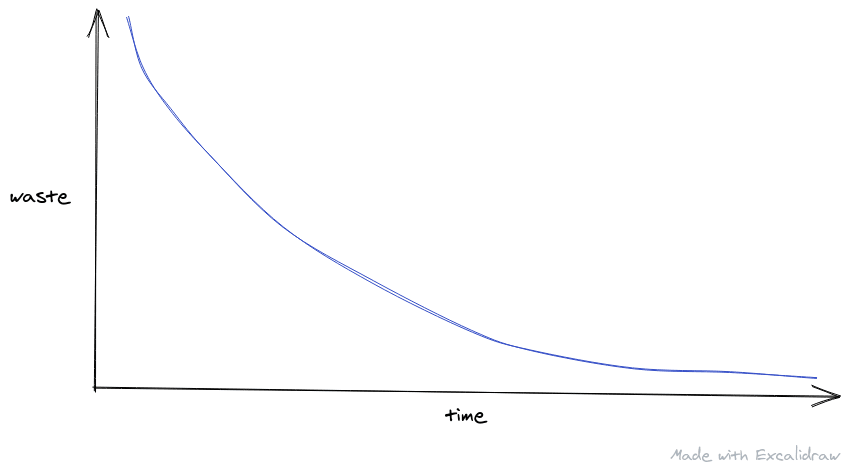

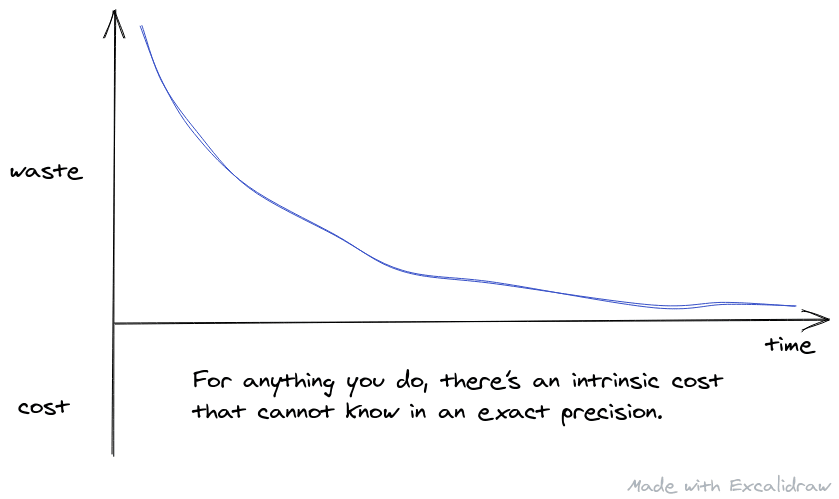
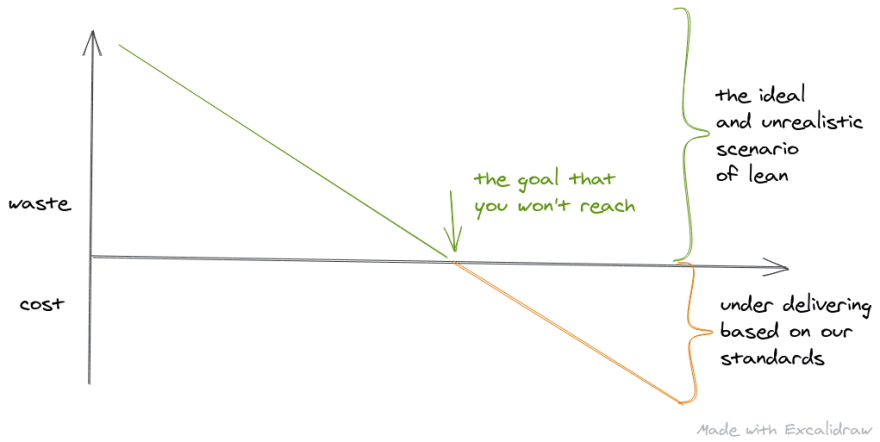
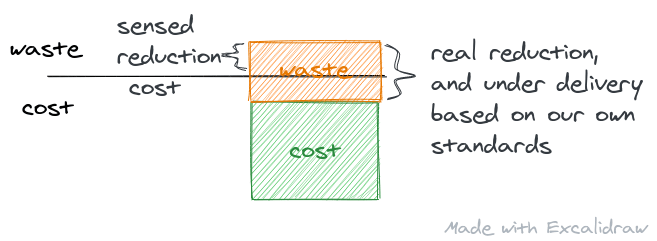


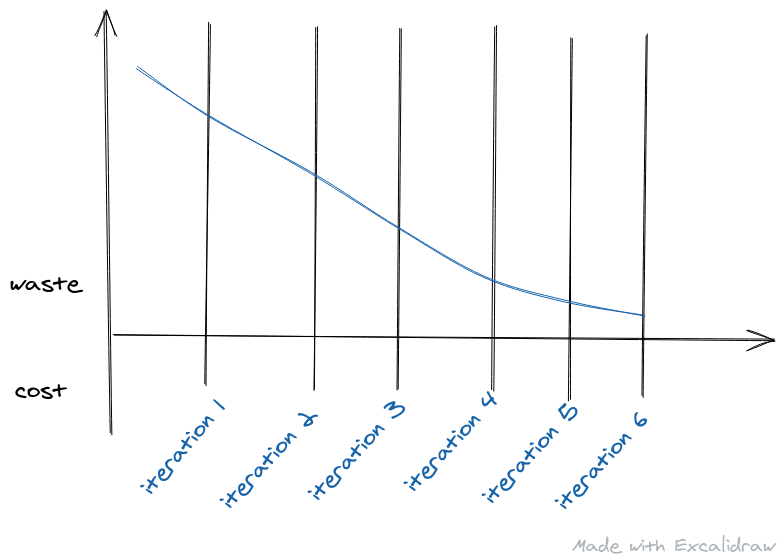

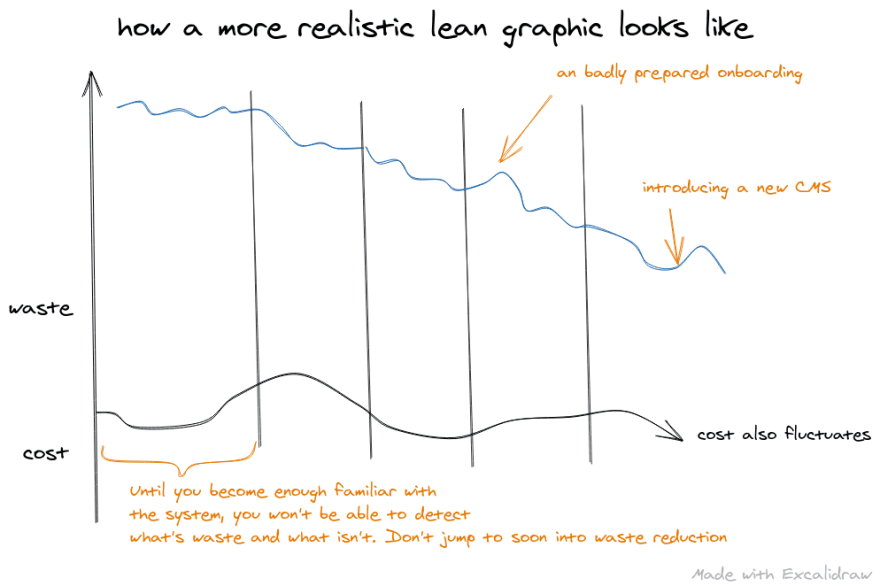

Oldest comments (4)
I really enjoyed your article. I can see some inspiration from A3s and maybe the Toyota Kata here.
The lean is waste reduction has always chaffed me. Mainly because people struggle to know what waste is. Even if you wrote the classic seven wastes, people still have a hard time attributing things correctly.
So one thing that you hit on at the end that I'd love more people do before they start any such lean endeavors is:
Know what the whole purpose of what you're doing is.
The purpose isn't improving the process. The purpose isn't writing software. The purpose is tied to a mission or a goal. Only when that is deeply understood can waste be identified. Once you really know your goal you can see the things in the way, the things slowing you down. Now you can apply your canvas and experiment.
Thank you for sharing your feedback! I really appreciate it 😄
100%. Knowing which is your purpose should drive everything you do, otherwise you take decisions based on what?
I seen too much "lean" arguments, which all were correct just because there was no shared goal/purpose, that let into the wrong direction and creating a false sense of "lean improvement".
Exactly!
Out of curiosity have you ever read the little book This is Lean? It treats this subject so elegantly. I've never found a better explanation of these concepts, some of the math, and great down to earth examples.
No, I haven't read that book! But it looks promising, definitely I will read it :)